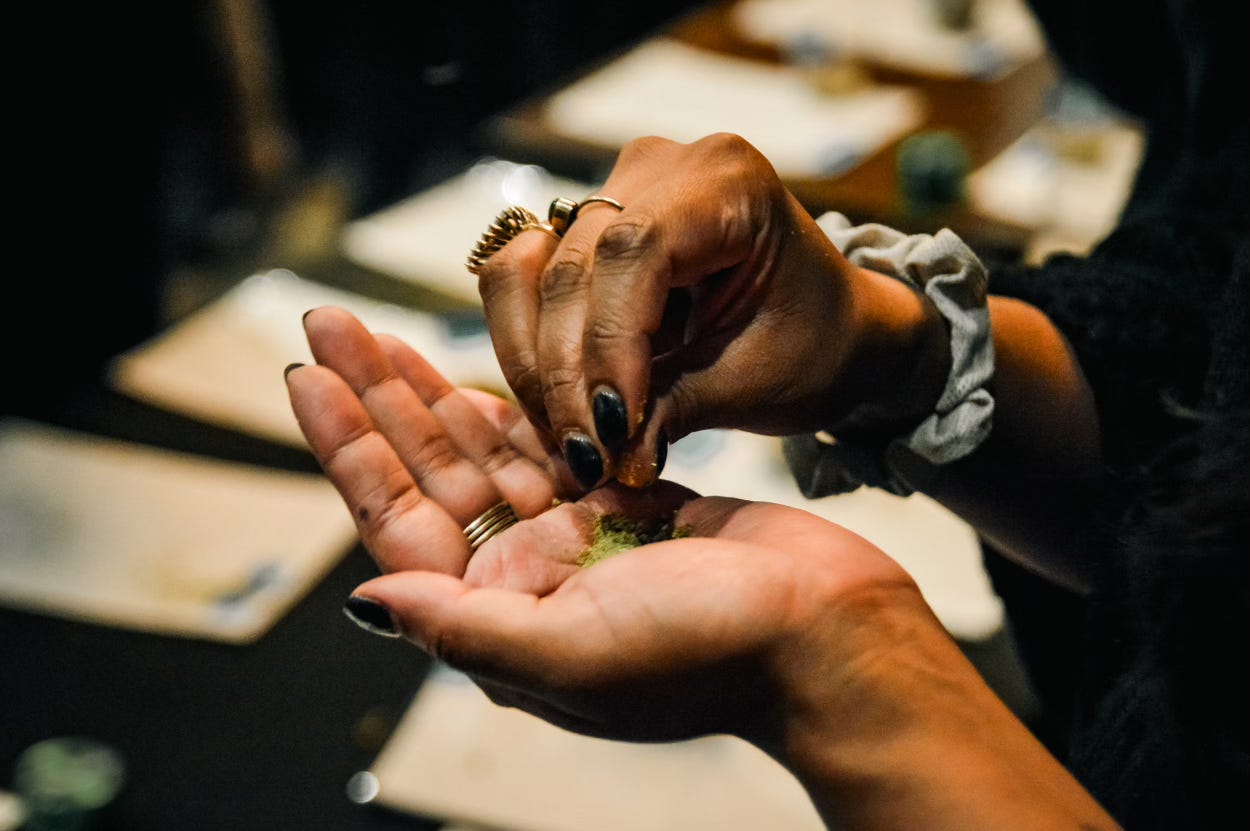When I first moved to Atlanta for a brewery job, I heard one thing over and over from the entirely male leadership team - that an existing employee had also interviewed for my position and they really wanted him for the job because he “looked like craft beer” but they hired me instead because I was more qualified.
Ever the holy fool, I asked what made him “look like” craft beer. You already know the answer (in case you don’t, I’ll get there in a minute), so let’s pause for a moment to say the quiet part out loud and consider how fucked up it is to tell an employee that they got the job despite not “looking like” they should have it.
“He’s got a big beard and beer tattoos.”
Ah yes, there it is. The stereotype that all brewers/people in beer are men with beards and tattoos who wear flannels.
Categorization is one of the most important mental acts we perform. Our brains process a lot of information. If we were aware of everything our brains are processing, then we would be unable to do anything, overwhelmed and paralyzed by the amount of data our brains process. Thus, our brains draw upon our past experiences and predict most of what we experience daily. Our brains use categorization to process information more efficiently. We navigate our environments by processing something’s total significance first and getting to the individual details later.
When we decide that a certain set of traits belongs to one group and a second set of traits belongs to another group, we then perceive those within the same group as more similar than they really are and those in different groups as less similar than they really are.
When we categorize, we polarize. Not only do we polarize, but we will act in ways that maximize the differences between “us” and “them” even when doing so detrimentally impacts our in-group. Multiple studies have shown that we are highly invested in feeling different from and superior to one another no matter how flimsy the grounds for our superiority are and no matter how self-sabotaging our actions end up being.
Not to be too rah-rah heart hands about it, but we can overcome unconscious discrimination by working together - across in and out groups - toward a common goal. The challenge is not how to stop categorizing, but rather how to recognize when we do it in ways that prevent us from being able to see individual people for who they really are.
Hear me out: what if we all just …stop saying that the stereotypical person in beer is a guy with a beard wearing a flannel? What if we let this stereotype die? I’m not saying that this one simple group goal is going to solve the problems in the beer industry, but it is actionable and a pretty easy action at that.
Also, your in-group affinity can be triggered by knowing you belong to a group. This is why visibility matters. Defaulting to using a stock photo of a white man with a beard and a flannel either staring contemplatively up into a glass of beer or crossing his arms in front of the stainless may seem innocuous but consider for a moment that the below pictures unexpectedly brought tears to my eyes when I saw them:1
I’m guessing the pictures weren’t composed to make me and others feel a visceral reaction. That’s what makes them so powerful. They capture people performing hop selection and those people look like me. They look like craft beer because they are people who work in craft beer.
What other stereotypes in the beer industry can we examine and work toward eradicating?
Hard Foam vs. Wet Foam
Last month, I visited the Czech Republic and Germany with my best friend. This is the third year we’ve taken a January trip to Europe (Munich in 2022, London in 2023) and we plan our trips around beer.2 As part of our vacation this year, we attended the LUKR Practical Pour Academy, which was a multi-day training at LUKR’s headquarters focused on proper Czech beer service using LUKR’s side pull faucets.
One of the most lasting lessons I learned during the course was the sensorial (organoleptic, if you’re nasty) properties of foam when poured as a “slow pour” versus a traditional side pull pour, which is not slow.3 Slow pours have become popular in the U.S. in the last few years, spearheaded by Bierstadt Lagerhaus. With a traditional side pull pour, the foam is poured first and then the beer is poured underneath the cap of foam.
A slow pour, on the other hand, is more akin to what’s colloquially known (by me and a few others, at least) as the “Mosher Pour.” In Tasting Beer, Randy Mosher advocates for pouring beer directly down the middle of the glass with no angle whatsoever.4 Pouring the beer down the middle of the glass rather than tilting the glass at an angle (most common in bar service) means that a lot of foam will be generated - more foam than if the glass is held at an angle. Mosher advises to let the foam settle, then repeat pouring until there is a dense, creamy foam. This dense, creamy foam is often referred to as meringue, after the French dessert of whipped egg whites and sugar. Did you even go to Denver if you don’t post a slo-mo video of the meringue on your Bierstadt Lagerhaus Slow Pour Pils?
Mosher asserts that this type of slow pour will knock out some of the carbonation in the beer, which makes the beer’s mouthfeel creamier. Additionally, he says that releasing some of the carbonation will also allow hop aromas to be more apparent. Another effect of the Mosher pour is that hop-bittering compounds will migrate to the head, making the foam taste more bitter than the beer.5
During our training, we learned that “slow” pours using side pull faucets used to be popular in the eastern part of the Czech Republic because tapsters would pre-pour around 200 beers for factory workers stopping by the bar after their shift rather than tap 200 beers the traditional way, with “wet” foam.
As part of this discussion, our trainer gave us one beer poured two different ways: one slow pour and one traditional pour, or one beer with “hard” foam and one beer with “wet” foam. He then handed each of us a spoon and told us to spoon some of the hard foam to taste and evaluate and then spoon some of the wet foam to taste and evaluate. Man alive, the difference was shocking and honestly I still haven’t wrapped my head around all of it. The hard foam was decidedly more bitter and had a dryer, less creamy mouthfeel than the wet foam. The wet foam, on the other hand, was much sweeter and creamier. While both heads were thick and long-lasting, I found that the wet foam served as a better “coming attraction” for the beer than the hard foam. The hard foam served as more of a contrast to the beer below it since it contained more hop-bittering compounds than the wet foam of the traditional pour. If I had been served both beers blind, I don’t know that I would have immediately picked up that they were the same beer based on how much the pour changed the sensorial aspects of the beer.
I’m still not sure what all this means for me in my beer-pouring practices. On one hand, I do love the Mosher pour in part because I love the ritualistic feeling of pouring a beer roughly, waiting for the foam to settle, layering more beer on top of it, patiently and lovingly waiting for the perfect glass of beer with that meringue foam. On the other hand, the wet foam was so much more flavorful. I think it comes down to a time and place decision for me. If you have the opportunity, I recommend trying this sensory experiment. If you do try it, let me know what you think!
And finally…
Before we leave each other, here are a few more things that I am up to these days:
Prepping for my upcoming presentation for MaltCon2024 on beer styles titled “Understanding Beer Style Anatomy.” This will be my first time presenting in person at the Craft Maltsters Guild annual conference and I’m looking forward to attending the conference as a speaker and not the main organizer.
Reading Sounds Wild and Broken: Sonic Marvels, Evolution’s Creativity, and the Crisis of Sensory Extinction by David George Haskell. I got very interested in sound and how we hear when I read The Sonic Boom: How Sound Transforms the Way We Think, Feel, and Buy by Joel Beckerman with Tyler Gray and started paying more attention to how sounds guide us through public spaces as well as more aware of what sounds I hear and don’t hear in my daily life.
Listening to Backlash: The Undeclared War Against American Women by Susan Faludi. Holy shit, does the United States hate women. I’m listening to the updated 2020 edition, and it’s already outdated because I have fewer rights now than I did in 2020.
These are from a hop selection event in Chicago for a collaboration brew called “Vibes since 1920” hosted by Solemn Oath Brewery and Hidden Hands. The release date hasn’t been announced yet, so make sure to follow @hiddenhandbeer and @solemnoathbeer for updates.
Because I think transparency is important, here are a few more details surrounding our annual winter vacations. We travel in January because it’s easier for both of us to take time away from work since January is typically pretty slow for the beer industry. It’s also wayyyyyyyy cheaper to travel to these destinations in non-peak travel seasons. As an additional bonus, the places we like to visit are devoid of large crowds of other vacationers, which means in some cases we get to do things like tour a palace basically by ourselves and visit tourist attractions where there’s only a handful of other people. The biggest downside is that the weather is typically pretty cold; however, cold weather is expected in January and we pack accordingly. We also have the ENORMOUS benefit of being able to fly at a steep discount because my friend’s husband is a commercial pilot. If we did not have the benefit of super cheap airfare, I would not be able to afford an annual European vacation and, in fact, at times my friends have covered the cost of my travel.
As someone learning to use a side pull faucet for basically the first time, I can attest that there is nothing slow about a proper Czech side pull pour.
Actually, he says that trickling beer down the side of a glass is for “sissies” because HAHAHAHAHAHA toxic masculinity and homophobia are hilarious /s, even when the book was first published in 2009 and then re-issued in 2017 and advertised as “Completely Revised and Updated.”
For more information about foam, check out my Zymurgy article, “Foamation: The How and Why Behind Beer Foam.







Great post, interesting and informative thanks!